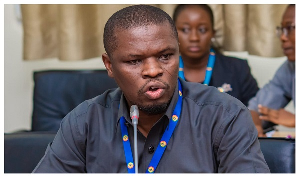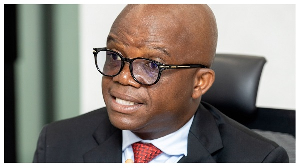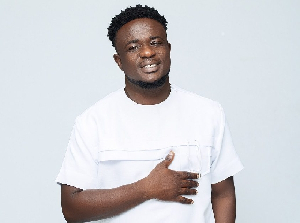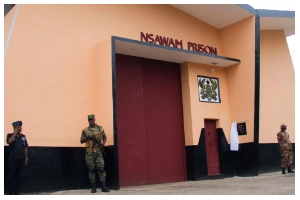Scancem Bribe: JOURNALIST CONFIRMS JJ, WIFE & PV WERE CITED IN COURT
Two Norwegian Journalists Insist They Stand By Their April 21st Story And
Expose Ex-Scancem Top Shot For Lying On ‘Radio Gold’!
Two leading Norwegian journalists, Geir Imset and Harald Vanvik, who co-authored the now famous story titled “GREY CEMENT – BLACK MONEY” published in the April 21-22, 2007 edition of a leading Norwegian business newspaper, DAGENS NAERINGSLIV (DN) have categorically stated that their April 21, 2007 story was a fair and true reflection and account of the court proceedings dealing with secret bank accounts in Luxembourg and Switzerland at the Asker and Baerum Court in Sandvika, Norway.The two journalists insisted that all the quotes attributed to former Norcem and Arker Head, Gerhard Heiberg, which had cited Ex-President Rawlings, his wife, Nana Konadu and Presidential Advisor, Mr. P.V. Obeng as recipients of bribe monies which the new owners of Scancem/Ghacem were alleging a former employee of the company, Mr. Tor Egil Kjelsaas had stolen, were indeed statements made by Mr. Heiberg in court in July and August 2006 during his testimony on behalf of Mr. Kjelsaas.
“Before we printed the article we sent all the quotes that Heiberg had made during the court hearing to him several days before the article was printed. He (Heiberg) sent us an email confirming what he had said in court and declined to make any further comments on the quotes”, Vanvik, the younger of the two Norwegian journalists, articulated.
“I don’t think he is right to deny the quotes now”, he added. When reminded by the Editor-in-Chief of The Crusading GUIDE, Kweku Baako, Jnr., that Mr. Heiberg had openly denied responsibility for the quotes attributed to him (Heiberg) by their newspaper (DN) on a Ghanaian radio station (Radio Gold), Vanvik retorted: “I have to repeat what I said earlier; that we were sending all the quotes to Mr. Heiberg. What we quoted him on in the article and he had no comments on his quotes in April. What has happened after that I don’t know”.
“I think it is very strange for Heiberg to say he never mentioned the names of Rawlings and his wife in court. It is very strange he is saying so because he got all his quotes before we published the article and he had no comments then. So it is strange that he is saying that he had not said what we published in our article a few months later. We published the article in April and we haven’t heard anything from Mr. Heiberg”, added he.
His colleague, Geir Imset, an investigative journalist of 30 years standing in Norwegian journalism, cut in to say: “It is surprising what he (Heiberg) is saying in Ghana today. It is also very interesting”. He wondered if indeed it was really Mr. Heiberg who had spoken to the Ghanaian radio station. One of the quotes attributed to Mr. Heiberg in the April 21 story was to the effect that “THERE WERE A NUMBER OF PEOPLE, BUT I DON’T WANT TO GIVE ANY NAMES. THERE WERE MANY PEOPLE, IN MANY COUNTRIES. THERE WERE MORE THAN RAWLINGS AND PV, INCLUDING POLITICIANS AND MANAGERS IN INDUSTRY”.
Another quote was: “THERE WERE, BY AND LARGE, BRIBES IN ALL COUNTRIES…IT WAS MY OPINION THAT TOR EGIL KJELSAAS WAS A VERY USEFUL MAN. HE HAD EXCELLENT CONTACTS WITH ALL POLITICIANS. EACH TIME KJELSAAS ASKED ME TO TRAVEL, I DID IT. I TRAVELED AND TOR EGIL KJELSAAS STAYED BEHIND AND GAVE ME ENVELOPES CONTAINING MONEY”.
Significantly, the former Head of Finance for Scancem, Per Gerhard Jacobsen who also testified in court on behalf of the accused (Tor Egil Kjelsaas) told the court how cash from Scancem’s Norwegian bank accounts was transported to Africa in envelopes to pay out the bribe monies.
“CASH WAS A PRACTICAL WAY OF DOING IT”, Jacobsen told the court. Gabby Asare Ochtere-Darko, the Editor-in-Chief of The Statesman who jointly conducted the August 8, 2007 interview with Kweku Baako, Jnr., wanted to know how the two Norwegian journalists came by the quotes attributed to Mr. Heiberg in the first place.
In response, Geir Imset said: “We got them (quotes) from a person who was there in the court when the statements were made. He was listening to the statements by the witnesses and taking down notes on what they (witnesses) were saying. We got his notes and on that basis we wrote the quotes and confronted several of the witnesses; asking them whether they (quotes) were correct; whether those were statements they had made in court, and they including Mr. Heiberg confirmed them (quotes)”.
Gabby probed further: “How did Gerhard Heiberg respond to your queries; did he say ‘no comment’ or did he give a positive affirmation? Did he say positively that ‘yes, these were the statements (quotes) that I made in court?’”
Imset continued: “As per the email Vanvik (his colleague) received from Heiberg, as far as I remember, he initially said, ‘I have no comments on these quotations’. Then afterwards in an interview with Vanvik the day after the publication, he praised the article for its fairness and accuracy”.
This prompted Vanvik to intervene. “Yeah, he (Heiberg) said the article was surprisingly correct or something to that effect. We had already printed the article and the paper was in circulation. I called Mr. Heiberg on Sunday (April 22, 2007), after we had printed the article because I wanted to know whether he had any reaction to or comment on the article, and he said he had read the article and he was happy with it”.
The two Norwegian journalists then indicated that their newspaper (DN) subsequently published Mr. Heiberg’s positive appreciation of their April 21st story in their Monday, April 23, 2007 edition without attracting any adverse or negative reaction from him.
“HE LIKED THE ARTICLE (APRIL 21ST STORY). HE LIKED IT. HE LIKED THE ARTICLE”, they contended enthusiastically.
“If you were asked or challenged to show evidence of your email correspondences with him, relative to these quotes and the article, would you be in a position to do that?”, queried Baako.
“Of course, if I am challenged in court it would be no problem for me to give out our email correspondences with Mr. Heiberg before we printed the article, of course”, a confident Vanvik underscored.
The two Norwegian journalists noted that there had been no complaints about their April 21st story from anybody since its publication in April 2007. Their paper is among the top-rated business newspapers in Norway and in the whole of the Scandinavian zone. Its circulation is 250,000 copies per day. “We have had no complaints from anybody. No complaints, nothing against anything written in the article since April 21, 2007. We haven’t had any complaint from Mr. Heiberg; he had never complained to us, or to anybody else that I know of. And we have not heard from Per Jacobsen or Tor Nygaard or Mr. Kjelsaas. We haven’t received any complaints from anyone that we had spoken to or quoted in our article since the publication in April”, articulated Vanvik in response to a question from Gabby.
One of the lawyers of Scancem, the plaintiffs in the case told Gabby and Baako that the DN’s April 21st story was mainly fair and accurate. “It contained minor errors of no substance”, he stressed, advising the two Ghanaian journalists, to go and consult the two Norwegian journalists for details in the unfolding saga!
Readers will recall that Mr. Heiberg engaged in a ‘cat and mouse’ game with the Editor-in-Chief of The Crusading GUIDE when the latter was recently in Oslo, Norway, to follow up on the Scancem bribery saga.
Various attempts to set up an interview with him via telephone proved futile as Mr. Heiberg claimed his busy schedule on International Olympic Committee (IOC) activities in China and North Korea, could not allow him the opportunity to answer questions from the Editor-in-Chief.
Stay tuned for Part 2 which will touch on other aspects of the court proceedings including what the two Norwegian journalists consider as documentary material supporting their story to the effect that ‘the Rawlingses’ and Co. were cited in court in addition to the ‘Heiberg Quotes’.
In the not too distant future, audio clips (and transcripts) of the recorded interviews with the key stakeholders (both official and unofficial) will be published and broadcast for the perusal of the Ghanaian public.
















